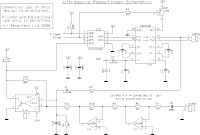This project started after I looked at the Polaroid Ultrasonic
Ranging module. It has a number of disadvantages for use in
small robots etc.
-The maximum range of 10.7 metre is far more than is normally
required, and as a result
-The current consumption, at 2.5 Amps during the sonic burst is truly horrendous.
-The 150mA quiescent current is also far too high.
-The minimum range of 26cm is useless. 1-2cm is more like it.
- The module is quite large to fit into small systems, and
- It’s EXPENSIVE.
Here in the UK from Maplin Electronics, the module costs GB38.00
and the transducer costs a further GB17.00. In fairness, the Polaroid
module does the job it was intended to do, which requires the range,
but that job is not to provide the eyes of a small robot.

more
Ultrasonic switch
Description.
A different type of remote control circuit employing ultrasonic signals
is given here.
The transmitter part of the circuit is build around IC1(NE 555).
The IC1 is wired as an astable multi vibrator operating at 40KHz.
The output of IC1 is amplifier the complementary pair of transistors
( Q1 & Q2) and transmitted by the ultrasonic transmitter K1.
The push button switch S1 is used the activate the transmitter.
The receiver uses an ultrasonic sensor transducer (K2) to
sense the ultrasonic signals. When an ultrasonic signal is falling on
the sensor, it produces a proportional voltage signal at its output.
This weak signal is amplified by the two stage amplifier circuit
comprising of transistors Q3 and Q4.The output of the amplifier
is rectified by the diodes D3 & D4.The rectified signal is given to
the inverting input of the opamp which is wired as a comparator.
When ever there is an ultrasonic signal falling on the receiver,
the output of the comparator activates the transistors Q5 & Q6
to drive the relay. In this way the load connected via the relay
can be switched. The diode D5 is used as a free wheeling diode.

more
Ultrasonic Sonar Range Finder with I2C Interface for Mobile Robots
The hardware described here is built up on a single sided PCB, size
49 mm x 50 mm. An Atmel AVR ATtiny26 microcontroller handles all the
needed tasks: I2C slave operation: communication to the I2C master
Stimulation of a resonant circuit embedding the ultrasonic sender Murata
Stimulation of a resonant circuit embedding the ultrasonic sender Murata
MA40B8S by 40 kHz PWM signal with defined duty cycle ratio
Adjusting the amplification (from 200 to 3500 in 16 steps) during echo
Adjusting the amplification (from 200 to 3500 in 16 steps) during echo
measurement according to a fixed time schedule (change of effective
resistors in the OpAmp feedback circuit) Time measurement until the
ultrasonic echo is received by the Murata MA40B8R



